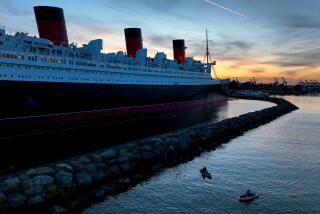Cruise Lines Are Equipped to Offer Variety of Medical Assistance at Sea
No one would intentionally set out on a dream vacation in need of medical care, right? But sometimes emergencies do happen.
Two weeks before singer/actress Connie Stevens stepped aboard ship for a 10-day cruise this summer, she was given a tetanus shot for a festering dog bite. Having taken the proper precautions, she supposed it was safe to travel.
But the slightly irritated puncture wound on one of her legs swelled into a life-threatening infection, at sea.
She had to be airlifted from her vessel for treatment on shore. Although any cruise line can arrange this service--within 48 hours--it’s unusual because cruise ships are equipped with state-of-the-art facilities that can handle just about any acute medical eventuality.
Most of the well-advertised floating pleasure palaces recognized by cruise enthusiasts are self-sufficient cities where the physician can reach a stricken passenger in two minutes. And in three more, have that same passenger reclining in a well-monitored hospital bed.
A detailed survey of 15 of the world’s leading cruise lines plus interviews with former shipboard physicians, led us to the conclusion that--for the most part--pharmaceutical capabilities, medical safety and comprehensive medical services are possibly more accessible to the hundreds of citizens aboard a “floating city” than to any other group of people on earth.
Some major lines provide a sterile operating facility where it is possible to perform routine emergency procedures such as an appendectomy, deliver a premature baby and maintain life support in a modern, fully equipped incubator.
Just about every major line is staffed by at least one doctor and two registered nurses. And Holland America ships offer the services of a dentist. The training of the medical staff reflects the standards established by the country in which the ship is registered.
Quality Nursing Staff
The strength of any shipboard health service is mirrored by the quality of the nursing staff. All nurses on commercial cruise lines are board-registered. Beyond their basic nursing educations, most have had X-ray and physical therapy training (especially helpful on world cruises with older folks who may slip on a lurching ship) and are obstetrical certified, although most cruise lines won’t accept passengers in their third trimester of pregnancy.
Considering the average age of shipboard passengers, the odds are better than average that a few will succumb to some medical complication. On any world cruise, as many as a third of the passengers will be over the age of 65. The medical staff is prepared to expect an acute cardiac problem as often as every alternate day.
Low Mortality Rate
Yet recent statistics of shipboard mortality rates among the 15 major cruise lines remain surprisingly low: just eight deaths in the last five years (one, a 92-year-old).
Surgery on the open sea can be a practical reality. Three to four major operations are performed each year in seagoing operating rooms that rival modern conventional hospitals. Cunard’s QE2 reports that procedures as complex as drilling life-saving burr holes in the skull of a crewman who fell down a hatch have been performed at sea.
But as in any general practice, the most persistent medical problems are minor annoyances.
Upper respiratory infection (a cold) is probably the most common complaint. Some people, not used to the constant chill of air conditioning, blame the environmental contrast between the interior of the ship (usually 70 degrees) and higher exterior temperatures on deck.
Acute gastroenteritis (upset stomach) is another health problem common to travelers. Passengers who visit shore tourist restaurants--and eat lavish salads handled by many hands in preparation--may well get it. However, doctors claim that crew members who eat ashore at small, family-run cafes fare better. There the food is more likely to be fresh, touched by fewer hands and less likely to be prepared in advance and left to spoil.
Combatting Seasickness
The incidence of seasickness varies, depending on sea conditions. The nurses might visit as few as 10 to as many as 25 passengers to give an injection of promethazine (Phenergan). One injection will usually carry a passenger through an entire voyage.
For oral use, most shipboard doctors prefer prochlorperazine (Compazine, Stemetil). It is especially effective for the symptoms of vertigo without the nausea component.
However, today’s new ships such as Carnival’s Tropicale, Princess’ Royal Princess and Sitmar’s Fairsky, with their heavy-duty stabilizers, hardly have the rock and roll problems of yesterday’s pleasure craft. In those sea-tossed times, sickness of passengers vied with the falls of crewmen to occupy a doctor’s day.
Most cruise lines require that you report any physical disabilities or illnesses requiring special treatment in writing when you make your cruise reservations. Patients with chronic illnesses should arrive with, preferably, brief reports from their physicians, and at least a list of prescribed medications.
As with many specialized on-board services, medical care is not included in the cost of your fare. Those who consult the ship’s doctor should not be surprised to receive an itemized medical bill at the end of their cruise.
More to Read
Sign up for The Wild
We’ll help you find the best places to hike, bike and run, as well as the perfect silent spots for meditation and yoga.
You may occasionally receive promotional content from the Los Angeles Times.






